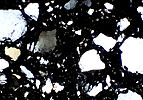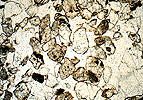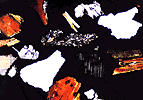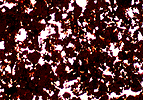3. Groundmass
They represent the soils' porous space, occupied by air and water.
In thin sections they are colourless with only the polarizer and when the analyser is placed, they are black (they include the isotope resin used to obtain the hardened block of the soil sample).
There are several different types:
![]() Simple packing voids. Equidimensional to elongated, interconnected, which are found between
skeleton grains. They are the result of simple packing.
Simple packing voids. Equidimensional to elongated, interconnected, which are found between
skeleton grains. They are the result of simple packing.




![]() Compound packing voids. equidimensional to elongated, interconnected, which are found between
aggregates, whose faces do not accommodate each other. They are the result of
packing the aggregates.
Compound packing voids. equidimensional to elongated, interconnected, which are found between
aggregates, whose faces do not accommodate each other. They are the result of
packing the aggregates.


![]() Complex packing voids. They are the voids between single grains and between the aggregates.
Complex packing voids. They are the voids between single grains and between the aggregates.
The voids are well observed with only the polarizer (PPL) but under these conditions the voids are confused with the colorless minerals. To overcome this problem, it is possible to work with the built-in analyzer (XPL) but now the small voids barely stand out and for this it is recommended to use the 1st order red quartz compensating sheet; but this sheet introduces into the voids a red interference color which resembles the red color of the basal mass of red soils. To solve this inconvenience, Guardiola Saenz patiently built a compensating sheet with a second-order green/blue interference color (he cut a section parallel to the C axis of a very pure prismatic quartz crystal and wore it down until it gave the desired interference color).
![]()
![]()
![]()
This sheet has helped the professors of the Department of Pedology of the University of Granada a lot, but thinking of helping those micromorphologists who do not have this sheet, we suggest using simple cello sheets as shown in the following figures (so that the cello does not may cause a possible deterioration of the final image, we propose to place the aforementioned sheet under the stage, above the aperture diaphragm, before the image of the microscopic field to be studied is formed).
![]()
There is a description of: shape, size, abundance and wall smoothness / roughness.